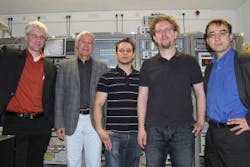Fast-Fourier-transform scheme allows a single laser to transmit 26 Tbit/s over 50 km

Karlsruhe, Germany--Scientists at Karlsruhe Institute of Technology (KIT) have developed an optical fast-Fourier-transform (FFT) scheme that allows them to encode data at a rate of 26 Tbit/s on a single laser, transmitting the data via optical fiber over a distance of 50 km, and successfully decoding the data.1
Decoding must begin as purely optical
The decoding method is based on initially purely optical calculation at the highest data rates, allowing the data flood to be split into to lower bit rates that can then be processed electrically. The initial optical reduction of the bit rates is required because no electronic processing methods exist for a data rate of 26 Tbit/s.
Led by Jürg Leuthold, the group used FFT-based orthogonal frequency-division multiplexing (OFDM) to encode the data. âThe challenge was to increase the process speed not only by a factor of 1000, but by a factor of nearly a million for data processing at 26 Tbit/s,â says Leuthold. âThe decisive innovative idea was optical implementation of the mathematical routine. Our result shows that physical limits are not yet exceeded even at extremely high data rates.â
In communications networks, lines with channel data rates of 100 Gbit/s are already in operation. Research is now concentrating on developing systems for transmission lines in the range of 400 Gbit/s to 1 Tbit/s. Hence, the Karlsruhe invention is way ahead of the game. Other European companies and scientists involved in the experimental implementation of ultra-rapid data transmission at KIT were members of the staff of Agilent and Micram Deutschland, Time-Bandwidth Switzerland, Finisar Israel, and the University of Southampton in Great Britain.
REFERENCE:
1. D. Hillerkuss et al., Nature Photonics, DOI: 10.1038/NPHOTON.2011.74.
(By entering the DOI number, the abstract can be viewed at http://dx.doi.org/ )
Subscribe now to Laser Focus World magazine; it's free!

John Wallace | Senior Technical Editor (1998-2022)
John Wallace was with Laser Focus World for nearly 25 years, retiring in late June 2022. He obtained a bachelor's degree in mechanical engineering and physics at Rutgers University and a master's in optical engineering at the University of Rochester. Before becoming an editor, John worked as an engineer at RCA, Exxon, Eastman Kodak, and GCA Corporation.